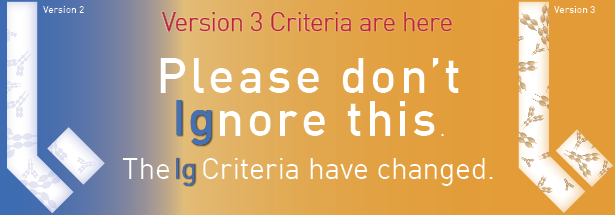The Criteria for Immunoglobulin Use in Australia (the Criteria) changed to Version 3 on 22 October 2018.
The Criteria has been released electronically within BloodSTAR and is also available at www.criteria.blood.gov.au. A printed version is no longer available.
Information for each medical condition can be printed from BloodSTAR or www.criteria.blood.gov.au if required, but any printed version must regularly be checked for currency.
Why did the Criteria Change?
-
To align with new evidence
-
To ensure those whose health is most likely to be improved with Ig therapy can get it
-
To manage the growth in demand for this precious, human-derived product.
Immunoglobulin (Ig) is a precious biological product derived from donated blood plasma, and as such, its use should be consistent with the evidence base and prescribed for the treatment of patients who are likely to benefit from immunoglobulin therapy, and for whom there are no safe and effective alternative treatments.
The continual significant annual growth in Ig use, the relatively high cost of Ig products and the potential for supply shortages mean that it is important to maintain a focus on ensuring that use remains consistent with an evidence-based approach and that Ig is able to be accessed under the National Blood Arrangements for those patients with the greatest clinical need.
- The demand for Ig in Australia continues to grow at a consistent annual rate of more than 10%. In 2016-17, a total of 5.54 million grams of Ig was issued, representing a cost of $532.3 million nationally (including the cost of plasma collections).
- The rate of increase of Ig demand is significantly above the rate of increase of Australian plasma collections by the Australian Red Cross Lifeblood, with the result that the proportion of Ig demand that is met by imported Ig products is also increasing each year.
The Criteria describes the conditions and indications for which the use of Ig is appropriate and government funded under the National Blood Agreement. Requests to access publicly funded immunoglobulin products in Australia must be authorised under the Criteria.
- The Criteria was developed in 2008 based on the available evidence and the advice of clinical specialists who are the experts in their field, and was partially reviewed and updated in 2012.
The Criteria has again been extensively reviewed by four expert Specialist Working Groups (in Neurology, Immunology, Haematology and Transplant Medicine) under the auspices of the National Immunoglobulin Governance Advisory Committee (NIGAC) and the National Blood Authority. All changes to the Criteria have also been subject to public consultation. Through this process the Criteria have been significantly strengthened in a number of important respects, as outlined further below.
- The Criteria has been revised to ensure that patients whose health is most likely to be improved with Ig therapy can access funded Ig products for clinically appropriate purposes, where there are no safe, effective and cost-effective alternative treatments
- The revised Criteria will more clearly articulate and standardise the qualifying criteria, dosing controls and length of authorisations and define clinical outcomes for continuing therapy to be able to access publicly funded Ig.
- The revised Criteria will assist with consistency of access and ensuring that the growth in demand for this precious, human-derived product is based on justifiable factors.
- The revisions will bring the Criteria are in line with current evidence and established clinical best practice.
- The changes to the Criteria will also assist hospitals in meeting Standard 7 – Blood Management Standard of the National Safety and Quality Service Standards (Second Edition).
What has changed and how does it affect me?
Changes to specialist requirements
In some conditions the revised Criteria will require patients to be diagnosed or reviewed by a particular type of specialist (for example an Immunologist) to access funded Ig.
- Patients may need to be referred to a different specialist as it is important to ensure correct diagnosis and management. Rural patients may benefit from telehealth or remote reviews
- Some patients may need to see their specialist more frequently to ensure they are responding to Ig therapy
- In some conditions the revised Criteria allow for the diagnosis to be made by additional specialist medical officers who may already manage patients with these conditions, which will improve ease of access
BloodSTAR checks the registration and specialty of all medical officers with the Australian Health Practitioner Regulation Agency (AHPRA). To be recognised as a specialist in BloodSTAR a clinician must be registered for the relevant specialist qualifications with AHPRA.
- BloodSTAR will only recognise a clinician’s specialties as registered in AHPRA
- BloodSTAR will now provide an early warning message during the process of seeking authorisation if a clinician’s speciality does not accord with the Criteria requirements, to allow correction before submitting the authorisation request
BloodSTAR improvements
BloodSTAR functionality has been improved so the system is easier to use and navigate. Information on the changes will be provided to all BloodSTAR users.
- Improvements in the keyword search function will make it easier to find conditions when commencing an authorisation request
- Data entry and requests have been improved in response to user feedback
Medical Conditions in the Criteria
There will be changes to a small number of medical conditions
- A small number of conditions in the Criteria have been merged with other conditions to better align with the predominant clinical features
- Following a review of the evidence, and based on expert clinical opinion and public consultation, Ig will no longer be funded for a small number of conditions. This is because there has been limited use, alternative therapies have been demonstrated to be more effective, or there is insufficient evidence to support the use of Ig therapy for those conditions
Indications for Ig Use
Indications for Ig therapy are now more descriptive to better support the decision to provide access to funded Ig therapy and assist the prescriber to select the appropriate criteria and dosing regimens.
Qualifying Criteria
The Criteria have been reviewed by expert specialist groups and updated to reflect current evidence and best clinical practice.
- For some conditions more evidence will be required to confirm that a patient has trialled first line therapies, where they are available and particularly if they are more cost effective
- In some cases BloodSTAR may ask for more clinical information (such as pathology results) to confirm the diagnosis and requirement for Ig therapy
- In some conditions, the Criteria are more definitive on when Ig therapy is indicated and more direction is provided regarding the types of investigations to be used in the assessment of patients. These assessment methods will provide consistency and allow comparison of results to determine clinical response to Ig therapy for re-authorisation at review. It may take a little more time to complete the additional information required.
Review Criteria
Formal patient review is required to continue receiving funded Ig as ongoing therapy. Minimum levels have been defined for the expected clinical response to Ig therapy in most conditions.
- The revised Criteria will provide greater guidance for prescribers regarding patient eligibility, and when a patient may be ready to trial off Ig therapy. For many conditions, patients who have previously trialled off Ig therapy and then relapsed will be covered by a specific indication
- Reporting of review outcomes will be possible and encouraged for all conditions, including those without ongoing treatment. For conditions that do not have ongoing treatment minimal data entry will be required for this reporting
Dosing
Dosing has now been defined for many conditions and recommended dosing levels are clearly described in the revised Criteria
Moving authorisations to the new version
Transition of existing authorisation records to the new version is largely managed automatically in BloodSTAR from the commencement of the new version of the Criteria on 22 October 2018, but some actions may be required of prescribers in order to complete this process, as outlined below. Further specific information is available in the condition specific factsheets and summaries of medical condition changes below.
- Most current patient authorisations have transitioned automatically when the new Criteria was released
- The initial qualifying criteria for some conditions has changed, so some patients will need to requalify in order to transition
- For some patients BloodSTAR may require some additional information at a patient’s first review after transitioning to the new version
- Further information required by BloodSTAR may include selection of the appropriate revised indication or specific condition, or providing clinical evidence such as pathology results, or confirming a patient’s clinical response to Ig
- For NSW health providers –existing patient authorisations were entered into BloodSTAR by a legacy process before the new version was released. These authorisations will also transition to the new Criteria in the same manner as outlined above
Fact Sheets for printing
The following fact sheets are available for printing and circulation:
 Detailed information from this webpage for Health Professionals (pdf) (3.11 MB)
Detailed information from this webpage for Health Professionals (pdf) (3.11 MB) Summary fact sheet for Health Professionals (pdf) (3.09 MB)
Summary fact sheet for Health Professionals (pdf) (3.09 MB) Summary fact sheet for Patients (pdf) (1.83 MB)
Summary fact sheet for Patients (pdf) (1.83 MB)- Summaries of medical condition changes in the Criteria by specialty for Health Professionals
- Condition specific fact sheets
- Version 3 Medical condition criteria
Important Links
For more information on the Criteria and the Immunoglobulin Governance program please visit https://www.blood.gov.au/Ig-governance
For the latest Immunoglobulin Governance updates visit https://www.blood.gov.au/Ig-program-updates
View the latest Version 3 Criteria newsletter here.
Keep up to date
Ig Program Updates provides a snapshot of the NBA’s current work program and priorities in the immunoglobulin space. It is updated quarterly.
To receive the latest Immunoglobulin Governance Program Updates by email, join the Ig Updates and National Immunoglobulin Interest Group (NIIG) subscription list: email Iggovernance@blood.gov.au(link sends e-mail) with the words SUBSCRIBE Ig Program Updates and NIIG in the subject line.
In the body of the email, please indicate your interest (e.g. Healthcare Professional/ Patient/ Government, etc.) and include your signature block.
Subscribers receive notification of the quarterly Ig Program Updates, and may also be invited to informally discuss and comment on individual Ig-related issues as they arise (participation is optional).
For more information on NIIG, see: www.blood.gov.au/Ig-committees.
For further information
Please contact the National Blood Authority on 13 000 BLOOD (13 000 25 663) or email IgGovernance@blood.gov.au.


